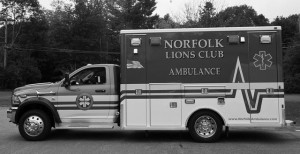Norfolk Ambulance Corps Hurting for Volunteers
Medical Responder Course Offered This Fall
By Wiley Wood
On a recent Saturday, Christopher Little manned a table at the Farmers Market draped with the banner of the Norfolk Lions Club Ambulance. People waved, stopped to chat or offered words of encouragement as they hurried past. Few seriously considered enrolling in the Emergency Medical Responder (EMR) course that the corps is offering at its headquarters this fall.
“We have plenty of moral support,” says Little, the corps’s deputy chief, “and we get enough financial support from the community, but what we really need is more bodies . . and right now we’re sucking wind.”

The Norfolk Ambulance is offering an Emergency Medical Responder course to help fill its dwindling roster.
The ambulance corps was formed in 1951 and has operated almost continuously since then. One of the last in the area to be staffed entirely by volunteers, it charges nothing for its services. Local calls to 911 are conveyed to on-duty ambulance members via radio.
Little attributes the corps’s difficulties in part to the graying of the ambulance volunteers. “At the moment we have three mainstays of the organization on extended medical leave,” says Little, citing shoulder and knee injuries.
The corps has 15 drivers and 19 medical personnel. “But as often happens, a handful of volunteers do 90 percent of the work,” said Little, “and I worry about burnout and the constant stress of just keeping things running.”
The EMR course takes 84 hours over two months, compared to the Emergency Medical Technician (EMT) course, which takes 190 hours over four months. Norfolk Ambulance is certified by the Connecticut Department of Public Health and is required to provide at least one licensed EMT and one licensed EMR on every call.
The Norfolk Lions Club Ambulance (NLCA) gets high ratings from those who have used its services. “I think they’re terrific,” said one Norfolk resident. “My house is difficult to get in and out of, and they really did a great job.” Another described calling 911 for dizziness and chest pains. Within minutes a familiar face was peering into his to inquire about symptoms. “They were fast, friendly and professional,” he said.
Little describes the ambulance corps as a congenial group, and the new ambulance building on Shepard Road as a huge success. “It’s amazing how architecture can affect an organization. It gives us tiny perks that mean a lot. Our meetings often become dinners, and people hang out in the day room,” says Little.
Towns are required to provide their residents with ambulance service, says Norfolk’s first selectman, Sue Dyer. If the volunteer service stopped functioning, Dyer would probably have to contract with Canaan or Winsted to fill the gap. Any replacement ambulance, Dyer pointed out, would almost certainly charge users or their insurance companies for service.
After an hour, as the crowds at the Farmers Market thickened, a woman came up to Little’s table. “I think I’ll take the course,” she said but was concerned about a particular date when she anticipated a conflict. Little was quick to assure her that her schedule could be accommodated.
The EMR course runs Monday and Wednesday nights from September 8 to November 10. Full details are available at norfolkambulance.com.
Photo by Bruce Frisch.
